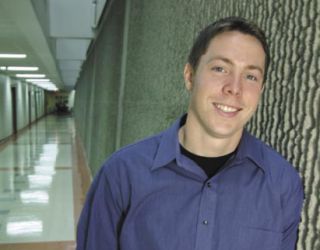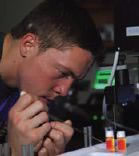 Mechanical Engineering Student Profile
Mechanical Engineering Student Profile
| MARK GRIEP, PHD STUDENT | |
 |
Engineering Across BoundariesAs countries worldwide become increasingly interconnected, engineering is going global.— Mark Griep For PhD student Mark Griep, the multidisciplinary nature of his doctoral research is indicative of engineering’s future. “Like most cutting-edge research, nanotechnology research occurs at the intersection of many engineering disciplines. In addition to mechanical engineering, I’ve had opportunities to work with chemical, electrical, and biomedical engineering techniques.” Griep, a recipient of the prestigious National Science Foundation (NSF) Graduate Research Fellowship, is part of a team that is researching and fabricating a protein-based nanosensor that will be used to detect minute concentrations of airborne toxic agents. The project, which is funded by the U.S. Department of Defense, was conceived as an alternative to the bulky detection systems currently used by U.S. military forces. “The end goal is to create a sensor that will occupy an area roughly the size of a computer chip, allowing it to be integrated into soldiers’ clothing or placed in a pen-sized device that can be launched into potentially hazardous areas to determine toxin concentrations,” says Griep.The sensor is a bio-electrical device that utilizes the unique properties of the optical protein bacteriorhodopsin and functionalized semiconductor quantum dots to convert optical energy into an electric signal. “We’re creating a functional prototype to detect a specifi c substance,” says Griep, “but the technology is designed for easy modifi cation to detect a full range of toxins with a single lightweight, manageable piece of equipment.” In addition to applications in smart munitions and enhanced soldier security, the sensor will have civilian functions in airports, hospitals, and other public spaces. Griep will spend a semester working on the sensor construction at the US Army Research Laboratory in Aberdeen and also at the Edgewood Chemical and Biological Center near Baltimore. After his projected PhD completion in 2008, Griep plans to continue his research with a post-doctoral position in Asia. “Global, social, and technical competencies are paramount to success in a rapidly changing engineering environment,” he says. “As countries worldwide become increasingly interconnected, engineering is going global.” |
|
Featured in Michigan Tech Research 2007 Mark Griep is engrossed in small matters in a big way. Griep, a PhD student in mechanical engineering, is on a team of students making a nano-sensor that detects biological and chemical toxic agents. The effort is sponsored by the US Army Research Laboratory and the Defense Ad-vanced Research Projects Agency. The sensor is a biological-electrical device, not mechanical, and it uses a protein as a switch or sensor that con-verts optical energy into an electrical signal. Current devices used to detect chemical toxins are big and slow, and they take a group to op-erate and up to an hour to work—fatal shortcomings when lethal toxins can strike in minutes. The idea behind the quick-response, nano-sensor is that in-dividual soldiers can carry one. “It’s potentially instantaneous,” Griep says, “and doesn’t have to be manually operated at all.”One-square-inch in size, the device will have a million sensors—vastly more than needed, but the technology is ripe with other applications, such as smart weapons; for instance, a robot, equipped with the nano-sensor, that troops could send around a hill to see if they are in harm’s way. Griep’s team includes other mechanical engineers, and students in electrical engineering, biology, and physics. He is happy to conduct practical, meaningful research. “The door is open,” he says of the opportunity. |
